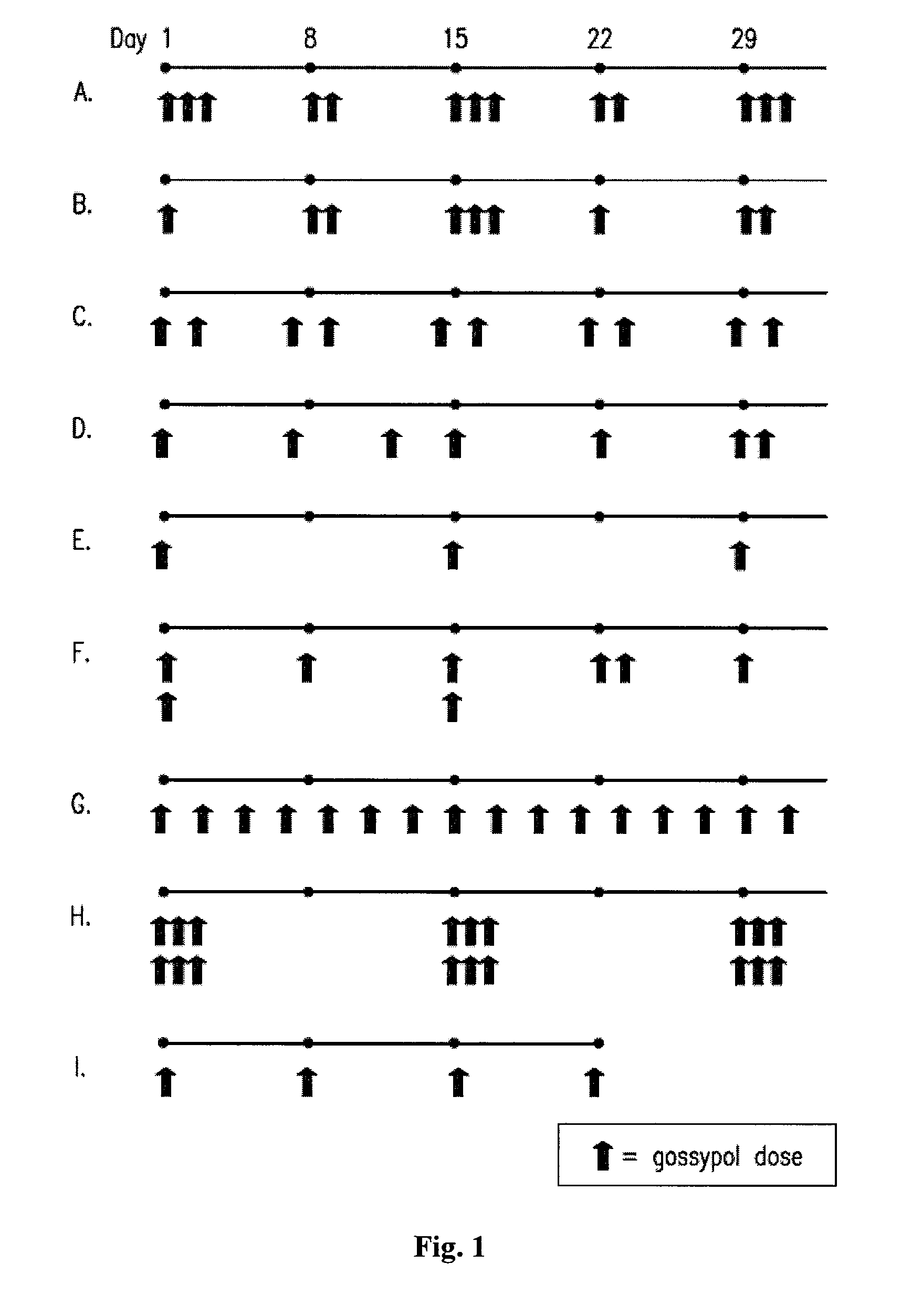Pulsatile Dosing of Gossypol for Treatment of Disease
a technology of gossypol and pulsatile, applied in the field of medicinal chemistry, to achieve the effect of reducing the number of one or more adverse events
- Summary
- Abstract
- Description
- Claims
- Application Information
AI Technical Summary
Benefits of technology
Problems solved by technology
Method used
Image
Examples
example 1
Pulsatile Dosing of Gossypol
[0157]A phase I clinical trial was carried out to compare the maximum tolerated dose and safety of daily (i.e., continuous) versus pulsatile (i.e., intermittent) dosing of (−)-gossypol in patients with advanced cancer. A secondary objective of this study was to identify any anti-tumor activity of (−)-gossypol. Patients were treated with increasing doses of (−)-gossypol according to the following dosing schedules: “Daily” dosing: 5 to 60 mg / day of (−)-gossypol on 21 days per 28 day cycle; “BID×3d” dosing: 30 to 80 mg BID of (−)-gossypol on 3 consecutive days (e.g., Monday-Tuesday-Wednesday) repeated every other week per 28 day cycle; and “Weekly” dosing: 80 to 200 mg of (−)-gossypol once weekly per 28 day cycle. Adverse events (AEs) were graded by NCI-CTCAE v3. Overall, pulsatile dosing (BID×3d and Weekly) resulted in a reduced percentage of AEs, particularly Grade 3 / 4 AEs, as compared to continuous daily dosing (see Table 2, Any AE).
TABLE 2(−)-Gossypol Do...
example 2
Clinical Efficacy of Gossypol
[0158]Following (−)-gossypol administration to patients with advanced cancer, clinical efficacy (e.g., patients having stable disease for 60 days or more) was monitored according to the following dosing schedules: “Daily” dosing: 5 to 60 mg / day of (−)-gossypol on 21 days per 28 day cycle; “BID×3d” dosing: 30 to 80 mg BID of (−)-gossypol on 3 consecutive days (e.g., Monday-Tuesday-Wednesday) repeated every other week per 28 day cycle; and “Weekly” dosing: 80 to 200 mg of (−)-gossypol once weekly per 28 day cycle. Pulsatile dosing (BID×3d) resulted in a longer median duration of days of stable disease as compared to continuous daily dosing (Table 3). Tumor types represented in this study included: non-small cell lung cancer, non-Hodgkin lymphoma, chronic lymphocytic leukemia / small lymphocytic lymphoma, colon cancer, breast cancer, small cell lung cancer, head and neck cancer, sarcoma, hepatocellular cancer, pancreatic cancer, esophageal cancer, cholangioca...
example 3
In Vivo Efficacy of (−)-Gossypol Acetic Acid Co-Crystals in the A549 Non-Small Cell Cancer (NSCLC) Xenograft Model
[0159]The in vivo efficacy of (−)-gossypol acetic acid co-crystals alone or in combination with taxotere (TXT) in the A549 NSCLC xenograph model is shown in FIGS. 2 and 3. About 5 million cells of A549 were inoculated into nude mice, 8 mice per dosing group. In one experiment, (−)-gossypol acetic acid co-crystals were administered at 15 mg / kg, oral dosing (po), daily for 21 days, either alone or in combination with taxotere at 8 mg / kg, iv, once a week for three weeks (FIG. 2). In another experiment, (−)-gossypol acetic acid co-crystals were administered at 60 mg / kg, po, daily for three days per week (day 1-3 / week) every two weeks (days 1-3, and then days 15-17), either alone or in combination with taxotere at 30 mg / kg, iv, single dose only, once every three weeks (FIG. 3). The results of these studies show inter alia that an intermittent dosing of (−)-gossypol acetic aci...
PUM
| Property | Measurement | Unit |
|---|---|---|
| Time | aaaaa | aaaaa |
| Time | aaaaa | aaaaa |
| Mass | aaaaa | aaaaa |
Abstract
Description
Claims
Application Information
 Login to View More
Login to View More - R&D
- Intellectual Property
- Life Sciences
- Materials
- Tech Scout
- Unparalleled Data Quality
- Higher Quality Content
- 60% Fewer Hallucinations
Browse by: Latest US Patents, China's latest patents, Technical Efficacy Thesaurus, Application Domain, Technology Topic, Popular Technical Reports.
© 2025 PatSnap. All rights reserved.Legal|Privacy policy|Modern Slavery Act Transparency Statement|Sitemap|About US| Contact US: help@patsnap.com



